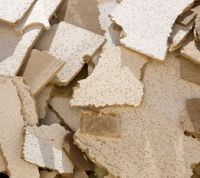

Important changes have been made to the management of gypsum waste. These changes aim to minimise the production of the odorous gas, hydrogen sulphide, at landfill.
The landfilling of gypsum in cells containing biodegradable waste has been generally prohibited since 2005, however the Environment Agency had previously allowed construction waste containing small amounts up to 10%) of gypsum to be landfilled with biodegradable waste deposits. This was purely for pragmatic reasons. This "exemption" has now been removed, so in effect all gypsum waste deposits must now be separated.
The criteria for the acceptance of gypsum and other high sulphate bearing wastes at landfill are set out in the Environmental Permitting (England and Wales) Regulations SI 2007/3538 (which have been replaced by the Environmental Permitting (England and Wales) Regulations SI 2010/675). In addition, a draft quality protocol for the production and use of gypsum from waste plasterboard has been developed by the Waste and Resources Action Programme (WRAP) and the Environment Agency, which aims to encourage the re-use and recycling of gypsum.